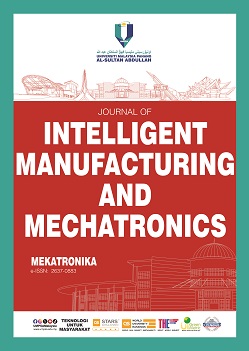Reduced Sliding Mode Control Algorithm for Two-Link Planar Robot System
DOI:
https://doi.org/10.15282/mekatronika.v7i1.11662Keywords:
Nonlinear controllers, Reduced sliding mode algorithm, Sliding mode control, Two-link planar robot, Tracking errorAbstract
Robots have become popular these days due to their ability accuracy and precision. Areas of applications include welding, machining, moving items, storage, retrieval and other precise surgical operations. Controllers are continuously being improved in design simplicity, robustness, and performance accuracy. High-accuracy trajectory tracking is a challenging area in robot control due to nonlinearities and input couplings. To achieve high accuracy and precision, robots need accurate, fast-processing controllers. This study there focused on application of the sliding mode controller (SMC) but in the reduced or simplified algorithm form (SSMC) for the control of a two-link planar robotic system. The MATLAB/Simulink software was employed. Result was evaluated using the root mean square error (RMSE) for both links. The proposed SSMC was compared with the PID and SMC schemes. The RMSE values of the tracking errors with disturbance for the SSMC were 0.0751 and 0.0814 rad, for the SMC were 0.0755 and 0.0817 rad and for the PID were 0.2784 and 0.1062 rad. The RMSE values with no disturbance for SSMC they were 0.07435 and 0.0811 rad, for the SMC were 0.0752 and 0.08153 rad and finally with the PID were 0.2579 and 0.1021 rad. The length of algorithm as shown in the text was shorter for the SSMC compared to the SMC and close to that of the PID. It is clear that he proposed control scheme SSMC is simpler than the SMC. It also had the property of improved performance with robustness.
References
[1] N. Nurnuansuwan, A. Lonklang, and K. Chamniprasart, “A prototyping of 2-dof robot arm using feedback control system.” In 2019 5th International Conference on Control, Automation and Robotics (ICCAR), pp. 368-372, 2019.
[2] R. Liu, G. Wakabayashi, H.-J. Kim, G. Choi, A. Yiengpruksawan, Y. Fong, et al., “International consensus statement on robotic hepatectomy surgery in 2018,” World Journal of Gastroenterology, vol. 25, no. 12, p. 1432, 2019.
[3] Q. Liu, Z. Liu, W. Xu, Q. Tang, Z. Zhou, and D. T. Pham. “Human-robot collaboration in disassembly for sustainable manufacturing,” International Journal of Production Research, vol. 57, no. 12, pp. 4027-4044, 2019.
[4] S. Surati, S. Patel, and K. Surati, “Background and research challenges for fc for healthcare 4.0,” Fog Computing for Healthcare 4.0 Environments: Technical, Societal, and Future Implications, pp. 37-53, 2021.
[5] M. S. Qureshi, P. Swarnkar, and S. Gupta. “A supervisory on-line tuned fuzzy logic-based sliding mode control for robotics: An application to surgical robots,” Robotics and Autonomous Systems, vol. 109, pp. 68-85, 2018.
[6] S. B. Niku, Introduction to Robotics: Analysis, Control, Applications, John Wiley & Sons, 2020.
[7] A. Gawel, H. Blum, J. Pankert, K. Krämer, L. Bartolomei, S. Ercan, et al., “A fully-integrated sensing and control system for high-accuracy mobile robotic building construction.” In 2019 IEEE/RSJ International Conference on Intelligent Robots and Systems (IROS), pp. 2300-2307, 2019.
[8] M. Sayahkarajy, Z. Mohamed, and A. A. Mohd Faudzi, “Review of modelling and control of flexible-link manipulators,” Proceedings of the Institution of Mechanical Engineers, Part I: Journal of Systems and Control Engineering, vol. 230, no. 8, pp. 861-873, 2016.
[9] Chaturvedi, Nirbhay Kumar, and L. B. Prasad. “A comparison of computed torque control and sliding mode control for a three-link robot manipulator,” In 2018 International Conference on Computing, Power and Communication Technologies (GUCON), pp. 1019-1024, 2018.
[10] Özmen, N. Gürsel, and Musa Marul. “Stabilization and tracking control of an xz type inverted pendulum system using Lightning Search Algorithm tuned nonlinear PID controller,” Robotica, vol. 40, no. 7, pp. 2428-2448, 2022.
[11] W. Zhao, Y. Zhang, and N. Wang, “Soft robotics: Research, challenges, and prospects,” Journal of Robotics and Mechatronics, vol. 33, no. 1, pp. 45-68, 2021.
[12] A. U. Darajat and S. Istiqphara, “Control of two-link robot manipulator with uncertainty parameter using self-tuning sliding mode control,” In 2020 3rd International Conference on Mechanical, Electronics, Computer, and Industrial Technology (MECnIT), pp. 376-380, 2020.
[13] M. Baccouch and S. Dodds, “A two-link robot manipulator: Simulation and control design,” International Journal of Robotic Engineering, vol. 5, no. 12, pp. 1-7, 2020.
[14] W. S. Aboud, H. K. Aljobouri, and H. S. Abd Al-Amir, “A robust controller design for simple robotic human arm,” Indonesian Journal of Electrical Engineering and Informatics (IJEEI), vol. 10, no. 3, pp. 655-667, 2022.
[15] A. V. R. Teja, C. Chakraborty, and B. C. Pal, “Disturbance rejection analysis and FPGA-based implementation of a second-order sliding mode controller fed induction motor drive,” IEEE Transactions on Energy Conversion, vol. 33, no. 3, pp. 1453-1462, 2018.
[16] C. L. Hwang, C. C. Yang, and J. Y. Hung, “Path tracking of an autonomous ground vehicle with different payloads by hierarchical improved fuzzy dynamic sliding-mode control,” IEEE Transactions on Fuzzy Systems, vol. 26, no. 2, pp. 899-914, 2017.
[17] M. Van, M. Mavrovouniotis, and S. S. Ge, “An adaptive backstepping non-singular fast terminal sliding mode control for robust fault tolerant control of robot manipulators,” IEEE Transactions on Systems, Man, and Cybernetics: Systems, vol. 49, no. 7, pp. 1448-1458, 2018.
[18] J.-J. E. Slotine and W. Li, Applied nonlinear control. Prentice-Hall Englewood Cliffs, NJ, vol. 199, no. 1, p. 705, 1991.
[19] H. K. Khalil and J. W. Grizzle, Nonlinear systems. Upper Saddle River, NJ: Prentice Hall, vol. 3, 2002.
[20] J. Liu and X. Wang, Advanced sliding mode control for mechanical systems: Design, analysis and MATLAB simulation. Springer Science & Business Media, 2012.
[21] N. S. Nise, Control Systems Engineering, (with CD). John Wiley & Sons, 2015.
[22] R. C. Dorf and R. H. Bishop, Modern control systems. Pearson, 2011.
Downloads
Published
Issue
Section
License
Copyright (c) 2025 The Author(s)

This work is licensed under a Creative Commons Attribution-NonCommercial 4.0 International License.




